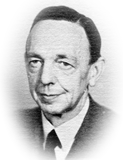Sidney
Herbert Witt (1923-1945)
|

|
The selection of Mr. Witt as the founder of the Research
Laboratories in 1923 was indeed fortunate. His technical
perspicacity and foresight, his early acceptance as an expert in
telecommunications in both Australia and overseas, and his long
tenure of office as "Head" of the Laboratories combined
to assist the development of the infant Laboratories to a mature
and effective working unit in the Department.
|
His vision of the Laboratories was that of a special
group set aside to advise the Department on how best to make use of
growing technology and this vision is still reflected in present day
statements of the functions of the Laboratories.
Mr. Witt joined the Department on 10th February 1910,
as a junior Instrument Fitter in the Electrical Engineer's Branch,
Melbourne Office, He was then almost 18 years old. By 1917, he had
advanced to Assistant Engineer, Class D, in Central Office, and had
already demonstrated his ability in 1913 by suggesting an improvement
to junction line circuits working between C.S. and magneto exchanges.
In 1921 and 1922, he undertook a study tour of
America, England and Europe, investigating the latest overseas
developments in telegraph, telephone and radio communication, and on
his return, he played a leading role in the planning of the
Australian trunk network. This led to his appointment as the founder
of the Laboratories in 1923 and his subsequent appointment as
Supervising Engineer, Research, in 1924.
For the first few years, Mr. Witt and his small team
of four concentrated on the introduction of voice frequency repeaters
and 3 channel carrier systems into the trunk network. In 1927 Mr.
Witt was seconded to play a leading role in the planning and
establishment of the National Broadcasting Service. This work
introduced the Laboratories to the radio broadcasting field as well
as that of telephone transmission, and many of the present-day
activities of the Laboratories can be traced back to these personal
activities of Mr. Witt and his early team.
Throughout his career, Mr. Witt was active in the
international telecommunications arena, becoming one of the first
A.P.O. representatives to participate in the activities of the
International Telecommunications Union (I.T.U.), and its associated
consultative committees in the post-war years.
Ultimately, this association led to Mr. Witt's
retirement from active control of the Laboratories in June 1945, when
he undertook a series of overseas assignments as Australian delegate
to international meetings of the I.T.U. These were mainly concerned
with formulating an international plan of radio frequency allocations
for radio communications and they led, at the Plenipotentiary
Conference of 1947, to the establishment of the International
Frequency Registration Board (I.F.R.B.) as a body of the I.T.U. Mr.
Witt was elected as one of the eleven original members of the Board
on the nomination of the Australian Government and took up full-time
duties in Geneva in January, 1948. He continued to serve on the Board
until his retirement in 1957, and served as its Chairman in 1949.
The dynamic personality of Mr. Witt was not confined
to departmental activities. He was an energetic member of a number of
professional associations, notably the Postal Electrical Society and
the Institution of Engineers, Australia, and a founder member of the
Melbourne Division of the Institute of Radio Engineers. Records show
that he frequently held important office in all of the above
associations and that he was a ready and lucid author of technical
articles in their respective journals. He was also a member of the
institution of Electrical Engineers, London, and of the Institution
of Post Office Electrical Engineers, London.
Sidney Herbert Witt died on 28th June,
1973, aged 81.
< Back to History of TRL
page
Last updated: May 2016
